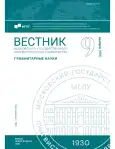Burrows’s Delta Measure as a Tool Resolving the Hymnographic Discrepancy Issue Between Collections (based on German Catholic hymnals)
- Авторлар: Koryshev M.V.1
-
Мекемелер:
- St Petersburg State University
- Шығарылым: № 9(903) (2025)
- Беттер: 53-61
- Бөлім: Linguistics
- URL: https://journal-vniispk.ru/2542-2197/article/view/342015
- ID: 342015
Дәйексөз келтіру
Толық мәтін
Аннотация
The paper aim is to identify and explain the differences between text collections of identical historical and cultural timespans that are contained in both editions of the Gotteslob – a prominent German-language Catholic prayer and hynmbook representing the vibrant hymnographic tradition of the last 50 years. The total data set includes 358 texts and 41,500 word tokens. Our stylometric analysis consistently relies on the Burrows’s Delta measure. The obtained findings demonstrate that German Catholic hymnography follows a nonlinear development pattern, characterized by the retrospectively ‘reinvented tradition’ of the hymnal genre; the latter largely explains the discrepancies between the studied text collections.
Негізгі сөздер
Авторлар туралы
Mikhail Koryshev
St Petersburg State University
Хат алмасуға жауапты Автор.
Email: m.koryshev@spbu.ru
PhD in Philology, Associate Professor, Associate Professor at the Department for Comparative Studies of Languages and Cultures
РесейӘдебиет тізімі
- Kovalev, B. V. (2024). From Сlassics to Digital Philology: On the Origin and Growth of Stylometry. Philologia Classica, 19(2), 347–360.
- Litvinova, Т. А. (2022). Stylistic identification of the author of the text. Voronezh. (In Russ.)
- Nenarokova, M. R. (2019). (Ed.). Christian Hymnography: History and Modernity. Moscow: IMLI RAS. (In Russ.)
- Burrows, J. F. (2002). ‘Delta’: a Measure of Stylistic Difference and a Guide to Likely Authorship. Literary and Linguistic Computing, 17(3), 267–287.
- Hoover, D. L. (2004). Testing Burrows’s Delta. Literary and Linguistic Computing, 19(4), 453–475.
- Argamon, S. (2008). Interpreting Burrows’s Delta: Geometric and Probabilistic Foundations. Literary and Linguistic Computing, 23(2), 131–147.
- Eder, M. (2015). Does Size Matter? Authorship Attribution, Small Samples, Big Problem. Digital Scholarship in the Humanities, 30(2), 167–182.
- Jockers, M. L., Witten, D. (2010). A Comparative Study of Machine Learning Methods for Authorship Attribution. Literary and Linguistic Computing, 25(2), 215–223.
- Hiley, D. (1993). Western Plainchant: A Handbook. Oxford: Clarendon Press.
- Unguendoli, F., Cristadoro, G., Beghelli, M. (2018). Stylometry and Automatic Attribution of Medieval Liturgical Monodies. Italian Journal of Computational Linguistics, 4(2), 91–105.
- Khokhlova, M., Koryshev, M. (2024). A Corpus of Liturgical Texts in German: Towards Multilevel Text Annotation. Proceedings of the Sixth International Conference on Computational Linguistics in Bulgaria (CLIB 2024, pp. 201–205). Sofia: Department of Computational Linguistics, Institute for Bulgarian Language, Bulgarian Academy of Sciences.
- Eder, M., Rybicki, J., Kestemont, M. (2016). Stylometry with R: A Package for Computational Text Analysis. R Journal, 8(1), 107–121.
- Admoni, V. G. (1964). Fundamentals of grammar theory. Moscow: Nauka. (In Russ.)
- Hobsbawm, E. (1983). The Invention of Tradition. Cambridge University Press.
- Hamacher, Th. (1985). Beiträge zur Geschichte des katholischen deutschen Kirchenliedes. Paderborn: s.l.
Қосымша файлдар










